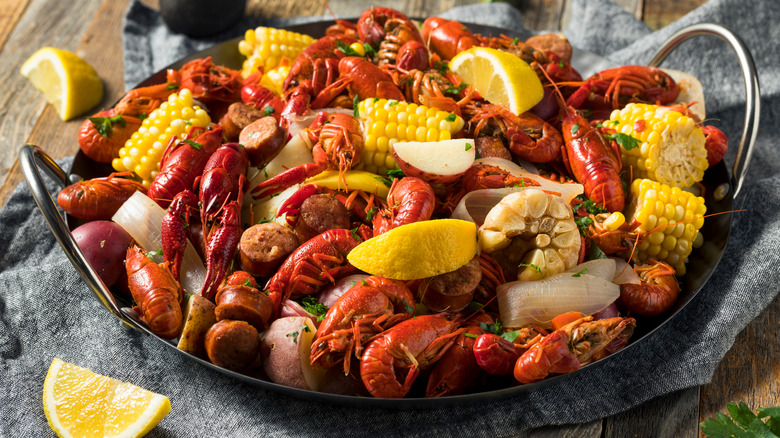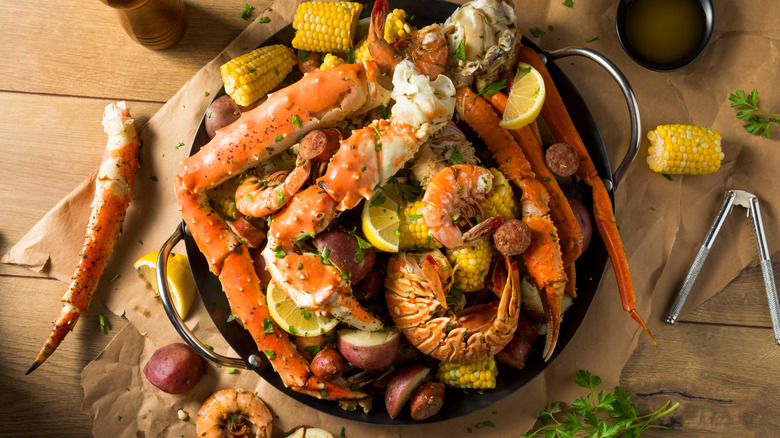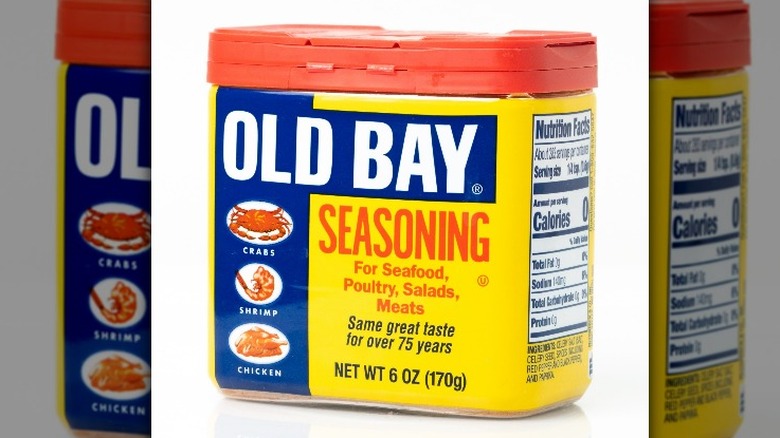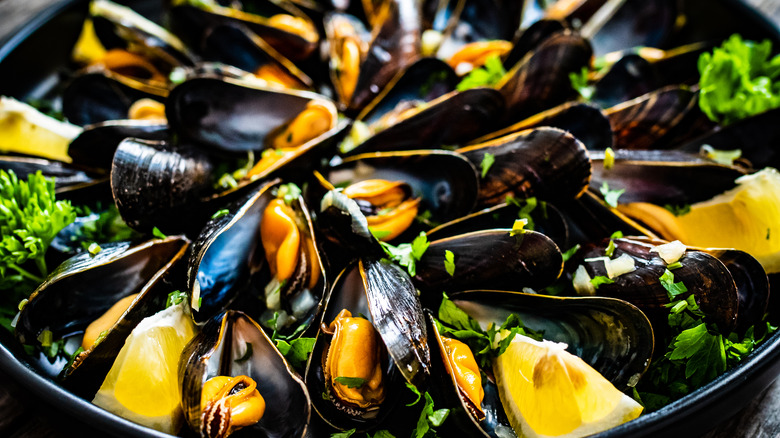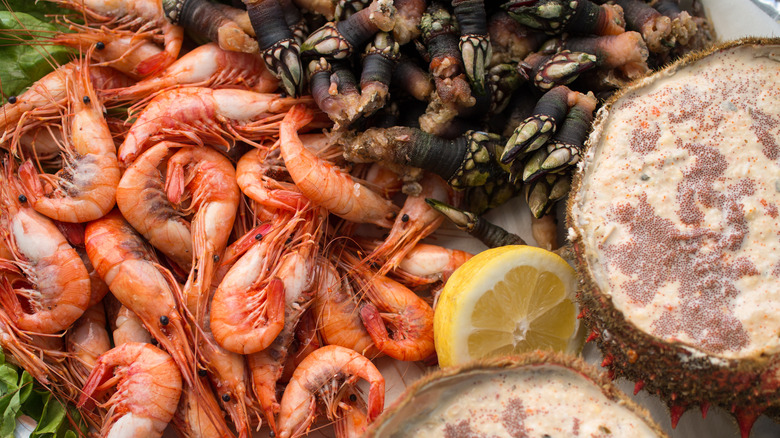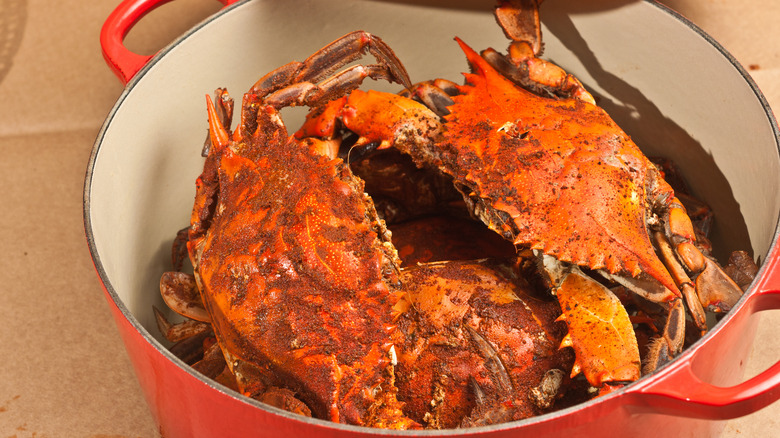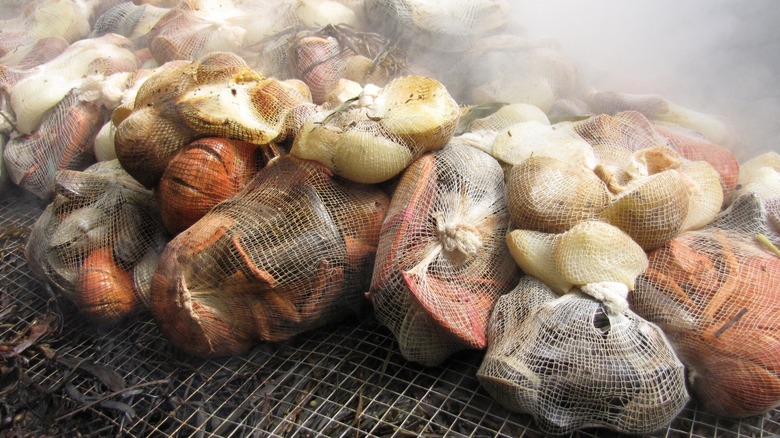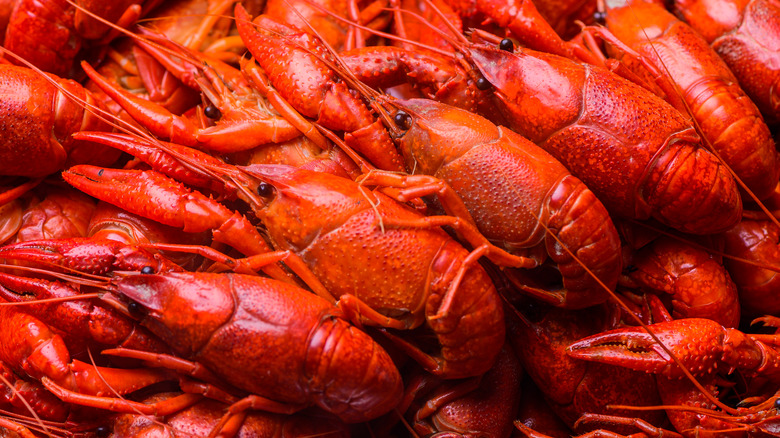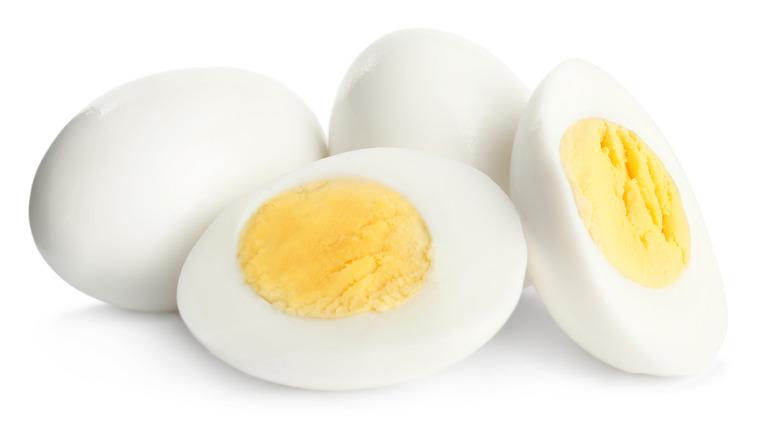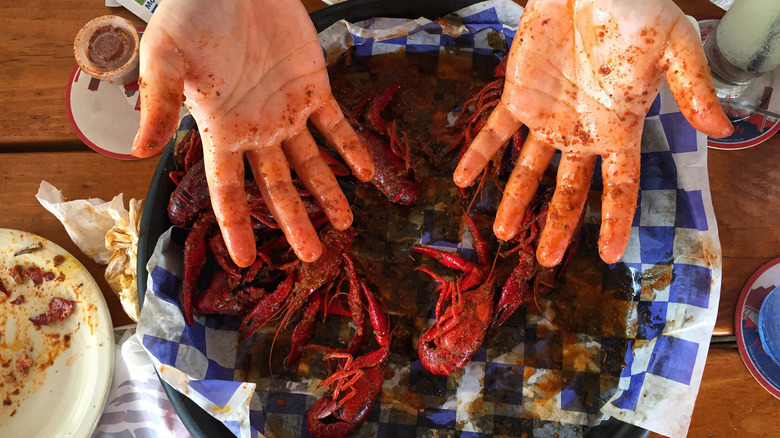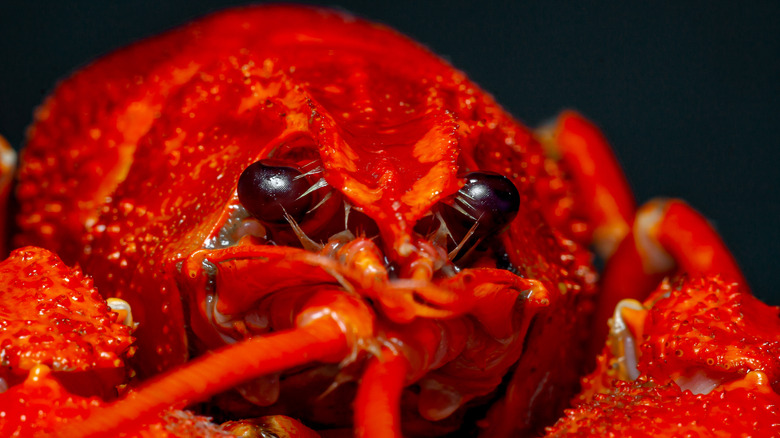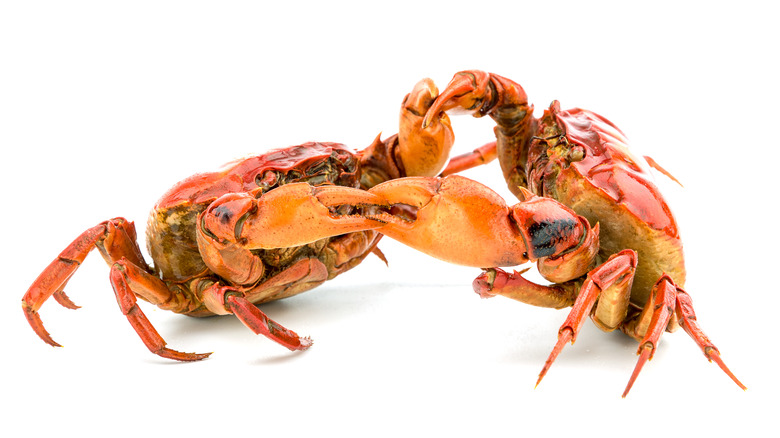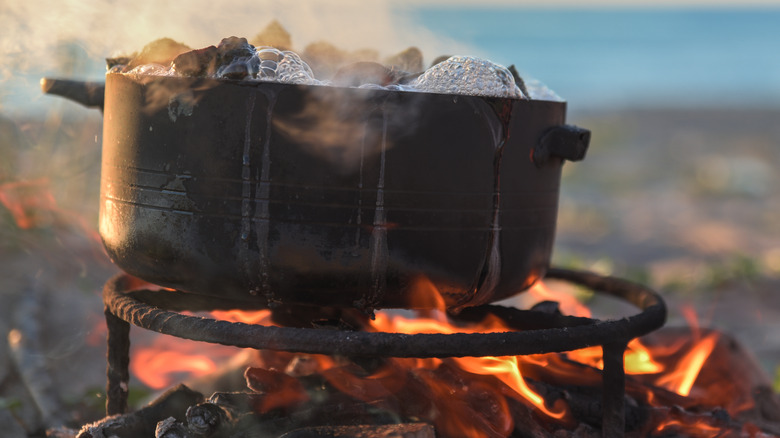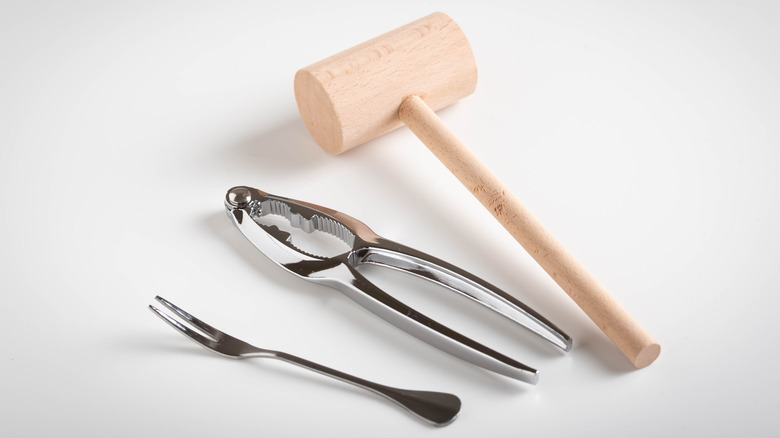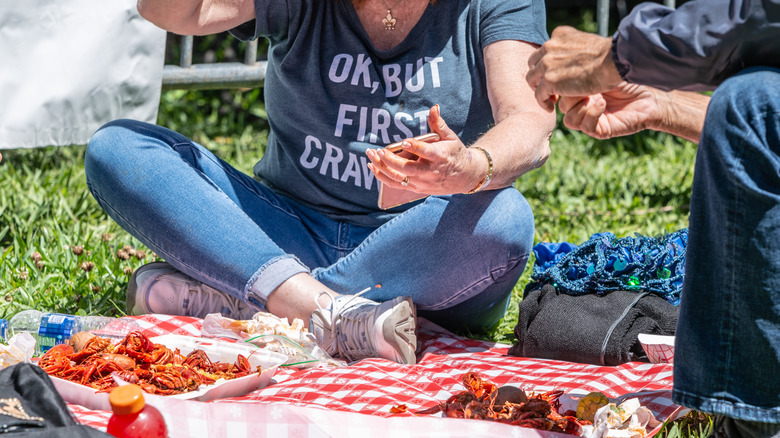The Untold Truth Of Seafood Boils
We may receive a commission on purchases made from links.
The summer months are all about enjoying your surroundings in the company of more than just a few good friends. Picnics are a universally fun and popular way to soak up some sun and divulge in good food, drink, and socializing. In fact, they're so popular that July has been designated as National Picnic Month, according to Days of the Year. Picnics are epic because they're universal — every culture has some form of this outdoor gathering, but no two are the same. The Smithsonian says that in the UK, they enjoy an assortment of foods like scotch eggs and potato salads. Having barbecues at the beach is the standard picnicking norm in areas where the climate is a bit hot or humid (like Hong Kong and India). Sitting under cherry blossom trees and enjoying watermelon and bento boxes is the Japanese picnic of choice (via Guru Navi).
In the United States, any open space can pretty much be utilized as a picnicking place, and when it comes to the most famous communal food gathering, no one does it better than the Gulf and Atlantic coastal seafood boil. These gatherings typically play out during the spring and summer months, when the weather is humid and unrelenting. Seafood boils have been going on since before the United States became the United States. So what exactly is it? Go get your grill prepped and your iced tea brewing, then read on to discover the untold truth of the seafood boil.
There are technically four types of seafood boils
Seafood boils aren't all created equal. What distinguishes the Gulf and East Coast styles are the actual proteins (and other ingredients) involved, the spices and seasonings, as well as the actual method of cooking.
Lobstergram (a specialty seafood delivery company) explains that Louisiana and Gulf Coast mainly boil crawfish and shrimp, and the occasional crab. These boils are also more vegetable-heavy, according to The Healthy Fish, and also contain corn, red potatoes, hard-boiled eggs, celery, onion, and lots of spice. South Carolina and Georgia stick with shrimp boils, adding in sausage, potatoes, corn, and sometimes ham. These regions typically stay away from adding extra spices and let the true flavors of the individual ingredients shine on their own.
If you head north towards the Mid-Atlantic and the Chesapeake Bay, the protein of choice is blue crab ... and it's not boiled, it's steamed. They also use Chincoteague oysters and clams. Lastly, the folks in New England pit-cook clams and sometimes lobster. They also have a variation of a clam bake called a clam boil, which uses a large stockpot with beer as the boiling stock, and clams, corn, potatoes, sausage, and sometimes lobster as the ingredients of choice.
Each region has their own special seasoning
No two seafood boils, bakes or steamer, are alike, especially when it comes to the spices and seasoning involved. While each individual boil master — the person in charge of the seafood boil (via Men's Journal) — has their own particular spice recipe and ratios, there are a few basic flavor additions that each locale typically uses.
Louisiana and the Southern Gulf Coast include mustard seed, coriander seed, cayenne pepper, bay leaf, dill seed, and allspice. While you can make this mixture fresh, it's commonly purchased as a premix crab boil packet and comes in both powder and liquid. Salt, hot sauce, and lemon are also frequently added. In smaller pockets of the coastal south, ketchup, Italian salad dressing, or a concoction of both are sometimes used instead (via Lobstergram).
Have you ever heard of Old Bay Seasoning? It's popular in the mid-Atlantic and Chesapeake Bay area, and can also be replicated with fresh ingredients. Keep in mind that this flavor-enhancing addition is made with not one, not two, not, three, but 18 ingredients. So yet again, it's probably best for your wallet to just buy it at your local grocer. New Englanders tend to stray away from adding extra flavors and prefer beer as their main flavor enhancer — not for drinking, but for boiling or steaming the shellfish. This is because once the alcohol evaporates, the food takes on the delicate aromatics and flavors from the beer itself (via Beer Institute).
France has their own version of a boil
This Southwestern maritime meal was created by local mussel fishermen, who discovered that pine needles make a great — albeit dramatic — way to cook bivalves (via Atlas Obscura). Known as éclade de moules (burst of mussels), the dish is so simple that it's frequently made during French camping trips.
The most simple method of preparation is placing live mussels either underneath or inside a bushel of dried pine needles, making sure that the hinge side faces up. This prevents any ash from falling inside the mussels once they pop open. Even more pine needles are added on top of the mound, and then the entire thing is lit on fire. The heat is so intense that it steams the mollusks in their own juices, and when they open, more of the piney essence is infused into the meat itself. They're typically served with white wine and a side of bread to soak up the shellfish broth. This down-to-earth (literally) method of cooking is a perfect example of working with what you've got (or what nature has readily available to you).
Seafood boils have Canadian origins
Seafood boils, particularly those focusing on the Louisiana crawfish, are frequently associated with the Cajun community. Those who are part of the Cajun community are actually descendants of Acadians, or French settlers, who, in the 1600s, made their way to what is now known as Nova Scotia (via National Park Services). When Great Britain gained control over the area in the early 18th century, the Acadians weren't too keen on swearing allegiance to the crown. The result was forced removal and relocation to Britain, France, the Caribbean, and British-owned colonies on the East Coast of North America. Instead of staying put under continued British rule, the exiled Acadians continued to travel down the East Coast, finally reaching what is now known as Louisiana.
While there's no definitive date as to when seafood boils actually became a thing, Every Culture notes that the traditional Cajun cooking styles can easily be traced back to their French roots. For example, simmered or boiled one-pot meals that use simple ingredients foraged from the immediate surroundings. Cajun food is also typically heavy on meat and seafood and bread also makes a frequent appearance. (Because how else would you soak up all the remaining seafood broth?)
In Maryland, it's not called a seafood (or crab) boil ... so don't call it that
If you're invited to a seafood-based picnic in Maryland, make sure that you don't call it a seafood boil — to do so will most likely get you a few squinty-eyed glares from the locals. That's because, in this neck of the woods, it's not a seafood boil, it's called a crab feast, according to Baltimore Magazine.
But why not seafood boil? Well, a few reasons, actually. The first is that in Maryland, the oceanic proteins involved aren't the same as the ones in a Gulf Coast seafood showdown. While both seafood boils and crab feasts use clams, in Maryland, you'll also find oysters, but the main event is the Atlantic crustacean delicacy, the blue crab. (And there's a lot of it, too.) The second reason is that these crabby little blue guys and their mollusk compadres aren't boiled — they're steamed. And just like their southern seafood boiling cousins, crab feasts generally happen during the summer months. Common side dishes include corn on the cob, carrot salad, pickled cucumber salad, and coleslaw and fries. Oh, and an ice-cold beer.
The New England clambake is based on a Native American cooking method
Pit roasting is one of the oldest forms of cooking in the world, according to hospitality blog Matador Network. It basically involves digging a hole in the ground, placing hot charcoals or baked rocks in the bottom, proteins or veggies on top of that, and then covering it with an assortment of ingredients from nature (like leaves, seaweed, and then enclosed with sand or earth). It's an incredibly lengthy process and can take upwards of 12 or more hours to finish cooking.
New England clambakes — also called clam steamers — are based on a similar pit-cooking method that was originally performed by coastal indigenous tribes. These communities would forage for seaweed (for layering and keeping the food moist), clams, crabs, and other mollusks, which were then cooked in beach-side earth ovens (via Northshore Magazine). While you can still find people cooking in the beach (pit-cooking style), Euclid Fish Company explains that it's more common to see beachside cookouts using propane grills or giant stockpots to steam the bivalves and crustaceans.
Louisiana is all about the crawfish
It's probably nearly impossible to think about Louisiana without imagining crawfish (or Mardi Gras, and also Swamp People). This celebrated little decapod was not only a source of nourishment for the Houma Indians but also was used as a symbol of courage and a source of nourishment for the local Houma Indians. It also served as a symbol of war — because crawfish raise their itty bitty (still pain-inflicting) claws when threatened, instead of backing down (via AP News).
This fresh-water cousin of the lobster is so beloved that in 1983, it was named Louisiana's state crustacean, writes Crawfish Haven. If that's not impressive enough, on March 7, 2017, the first crawfish pardoning ceremony took place, which granted Emile the mudbug a life free from worry where he could live out his days in Bayou Segnette State Park (via Louisiana Travel).
Often referred to as the "poor man's lobster," what distinguishes one from the other is size, habitat, lifespan, diet, and coloration, explains A-Z Animals. Crawdads are only found in freshwater, live off detritus, are usually dark blue, green, or black, and live upwards of 20 years (unless they end up in a boil). They're also wee little guys, topping off at inches in length. (They're little but mighty.) Lobsters reside in saltwater, are blue to greenish-brown, eat whatever they can find (including each other, notes NPR), can grow up to 20 inches, and live over 100 years.
It's not uncommon to find chicken eggs in a boil
While ingredients like sausage, corn, and potatoes seem like somewhat normal ingredients that could be found at a barbecue or seafood boil — they are, after all, filling, relatively inexpensive, and when it comes to seafood boils, add different textural and flavor nuances. But if you're confronted with a hard-boiled egg that isn't deviled, it might throw you for a loop.
Though it might sound weird to those of us who aren't well versed in the fine art of seafood boils, the hard-boiled egg is a common and also important ingredient. Oh So Foodie explains that hard-boiled eggs actually soak up a lot of the spices, which basically keeps the entire feast from getting overly seasoned (or overly spicy). Potatoes act the same way (via Foodal). So next time you're confronted with potatoes and hard-boiled eggs mixed together with the crawdads, corn, crabs, and sausage, just think of them like little edible flavor sponges.
Seafood boils are all about the mess
Seafood boils, clam bakes, crab steamers, and everything in between are essentially just big social gatherings based around all things seafood, according to The Healthy Fish. So you'd better feel comfortable around the people you'll be nudging elbows with ... because these sea-foodie feasts are M-E-S-S-Y. (As in, you can guarantee you'll be eating and wearing your food.)
A proper boil is done outside, and the seafood and accompanying ingredients are either boiled, baked, or steamed, and then served up "family style." This method of serving requires a long table, or two wooden picnic tables pushed together, for example. (Or maybe more than two tables, depending on how huge the crowd ... they tend to attract a lot of attention.) To make clean-up easier, the table is covered with a table cloth, newspaper, or brown paper bags to help absorb all the buttery juices.
If you're attending a southern seafood boil, don't expect to find much by the way of utensils or cutlery. Those are pretty much out of the question (although the tables might have a few mallets scattered around to use for cracking crab claws). If you look around, you'll notice that everyone is using their hands, which are also what a chef calls the "best tool in the kitchen" (via Medium). So ... if you're not making a mess, you're doing it all wrong. There's no shame in wearing a seafood bib.
Don't be afraid of this heady delicacy
As previously mentioned, if you're attending a gulf coast or southern seafood boil, don't expect to see anything that resembles a fork or knife. When those freshly boiled crawdads are poured onto the tablecloth in front of you, the only expectation — besides enjoying yourself thoroughly — is to simply dig in.
If you've never attended a boil, just note that there will be a lot of cracking, snapping, and slurping ... and that's all part of the experience. While your fingers are most likely no match when it comes to breaking through a crawdad shell, the secret is to twist the tail, and it should separate clean from the crustacean's noggin. The next part — and there's really no "proper" way to say this — is to suck the head. As horrifying as this might sound (to those who aren't well-versed in mudbug consumption), this is one of the best parts of the animal and shouldn't be discarded (via Crawfish Cafe). This tiny morsel of "crawdad butter" is packed full of concentrated flavor and is actually considered to be a delicacy.
But contrary to what you might think, you're not sucking down on crawdaddy brain matter. Oh, no. These little water bugs don't have a brain. What you're actually slurping down is an organ that's more similar to the human liver. If that still makes you feel uneasy, just think of it like crawdad pâté.
Of course, there are seafood boil competitions
When it comes to competitive cook-offs, it's safe to say that no food is ever off-limits. There are chicken wing wars, taco tournaments, rib races, and burger brawls, just to give a few examples. Of course, while seafood boils may seem to be a bit of a niche market, they're not exempt from a good, old-fashioned friendly foodie feud.
Seafood boil competitions tend to focus mostly on crawdads as their main protein, and frequently occur during the crustacean's usual season — the warm and oh, so muggy, spring and summer (via Happening Next). During these months, these mighty little mudbugs tend to be larger and more plentiful, but also tend to be more flavorful (via We Love Crawfish). All that being said, seafood boils of any kind can typically produce a lot of tasty nomnoms, which can ultimately mean two things: a limit on the number of competitors and the oh-so-necessary very large — and very hungry — crowd of spectators.
Boils generally use high-capacity stockpots that can hold anywhere from 30 to 100 quarts (depending on the size of the gathering). A 30-quart stock pot can hold a 15-pound bag of crayfish, with the average eater consuming around 3 to upwards of 5 pounds of little bitty lobsters. What we're trying to say is that at a competitive seafood soirée, don't expect to leave hungry.
It's not the same if you're not outdoors
Part of the experience of a seafood boil is being outside in nature (via Southern Discourse). It's basically like a giant picnic barbecue with more than a few good friends and family. Most of the time, the main event (crawfish, shrimp, or crabs) is actually sourced right before cooking. It's almost like farm-to-table dining, but without the farm. Being indoors would just add an unnecessary hindrance in getting those fresh (and lively) components from point A to point B.
While it's not unheard of to have smaller stovetop seafood boils, these are typically for family dinners or small parties ... and the food is probably still eaten outside (and the house allowed to air out) because if you've had the pleasurable experience of smelling boiling seafood in an enclosed area, you know that it has a rather uniquely pungent aroma. (An aroma best suited for an outdoor gathering, and not marinating your couch, throw pillows, and carpet in its funk-tastic scent.)
A traditional clambake uses a stock pot and propane stove, just like the seafood boil. But if you're going to go the traditional clambake cooking route, you're going to need a beach. Clam bakes use a pit-cooking method and require fire, hot rocks, and freshly picked seaweed. So, unless you literally have the ocean shore at your backdoor, you're going to need to be outside. But since when was being outside in nature ever a bad thing?
You need to be properly equipped for a seafood boil
You can't just take some big soup pot and put it over an open fire in the hopes that your seafood boil will be a success. You're going to need specific tools and gear in order to make your seafood boil a boil to remember (in a good way).
The first thing you're going to need to invest in is a large stockpot for the actual boil ... and it has to be large (as in, at least 52 quarts or more). This specialty stockpot also needs to come with an inner strainer, because you can't just go dumping boiling seafood and the actual liquid on a table for everyone to enjoy. It doesn't work that way. You're also going to need a heating element, like a propane stove made specifically for seafood boils. Heat-resistant gloves (for the boil master), boil bags, and a large spoon (or paddle) are also necessary.
For eaters, you'll need a tablecloth, and more than a few napkins. Oh, and bibs. Don't be a rookie and refuse a seafood bib. If you refuse to wear a bib, and you've never attended a boil before, then expect to be labeled noob as soon as you ruin your nice white shirt with buttery, red-hot seafood stock.
If you're attending a crab feast in Maryland, at least you'll also be lucky enough to get the necessary utensils for crab-eating (crab claw crackers, scissors, and special crab forks).
It's typically a warm season experience
Crawfish and seafood boils are mostly reserved for the spring and summer months. This is because the primary ingredients in southern boils (crawfish, shrimp, and crab), all have a similar season where they're more plentiful and also taste better (via Southern Living). While crawfish season can vary from Texas to Louisiana, spring and early summer — typically February through May — are when they taste the best. (But if the winter is warmer and wetter, then they can still be plentiful from November to July.)
In South Carolina, shrimp season comes twice a year, writes South Carolina's Information Highway. The first season produces smaller brown shrimp, and runs from May through August, while white shrimp season begins in September and ends in December. When it comes to crab, it's a mixed bag. Some states, like Florida and South Carolina, have a year-round crab season, while Maryland's season runs from April to November.
Cleveland Scene says that there really is no designated "clam season" because of their year-round availability. The outlet also notes that autumn seems to be a great time for clambakes because of the rapidly cooling weather and the beginning of the harvest season. (By the way, we're talking about Cleveland, Ohio, which is about 416 miles inland from Maryland, according to Travel Math.) This autumnal feast happens annually, with the bivalves shipped fresh from the East Coast. (Which proves that you can enjoy a seafood feast pretty much anywhere in the US.)
